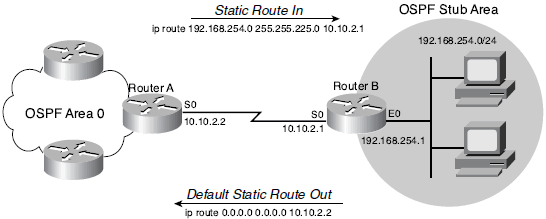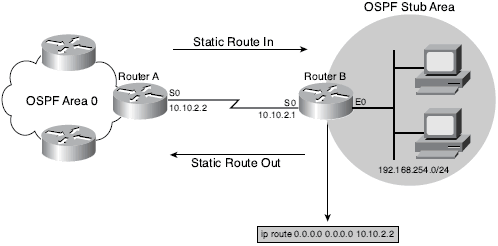Basic Routing Protocol Operation
Consider an example of a router that is initially configured with two networks to which it directly connects. The router has only these two networks in its routing tables. However, other networks beyond the initial two are not entered into the routing table because they do not directly connect to the router. So how does the router recognize these other networks? This can be accomplished in the following ways:
- Static routing-A manually defined and installed type of route within the router as
the only path to a given destination. This type of routing forces the destination within
routing tables. This type of routing also takes precedence over routes chosen by
dynamic routing protocols. Figure below shows an example of where to place a static
route and how a static route is used. Static routing is not an effective stand-alone
solution in a medium- to large-sized network because the work needed to make the
network run something is very large. The most common use of static routes is in stub
networks, as shown in Figure below. In conjunction with a dynamic routing protocol
such as OSPF, this synergy works well.

- Default routing-A type of route within the router that is manually defined as the
path to take when no route to the destination is known. The router to which this
information is sent is also known as the router or gateway of last resort. Figure below
shows the use of a default route, which can make routing easy.
In Figure below, all traffic that Router B receives is forwarded to Router A's S0 interface if it is not for the E0 network, 192.168.254.0/24. - Dynamic routing-Uses routing algorithms that analyze incoming routing update messages from one or more routing protocols to determine the optimal path to a destination. This type of routing has the greatest advantage in that routing automatically adapts to a change in the network's topology.

Dynamic routing is the most commonly used method of routing. Associated with this type of routing are several terms and characteristics that define how it operates, such as convergence and accuracy.
In dynamic routing, the routing table must consistently reflect accurate and up-to-date information concerning the network topology. The amount of time that it takes for changes to be reflected in every network router's routing table is known as the convergence time. Convergence, in this context, is the act of approaching the state where all routing tables have congruent information and are in steady state.
Having a routing protocol with a fast convergence time is desirable because disruption of routing can occur during the time that a router spends calculating the new optimal path.
In this tutorial:
- OSPF Basics
- What Is a Routing Protocol?
- Basic Routing Protocol Operation
- Link-State Versus Distance Vector Routing Protocols
- Link-State Routing Protocols
- OSPF Characteristics
- Integrated Intermediate System-to-Intermediate System
- Distance Vector Routing Protocols
- Selecting a Routing Protocol
- Operational Considerations
- Protocols Supported
- Routing Hierarchies
- IP Address Management
- IP Encapsulation Support
- Technical Considerations
- Routing Updates
- Scalability
- Business Considerations
- SPF Overview
- OSPF Routing Hierarchy
- Hierarchical Network Design Techniques
- Routing Types Within an OSPF Network
- External Routes
- OSPF Areas
- Characteristics of a Standard OSPF Area
- Stub Areas
- Not-So-Stubby Areas
- OSPF Operational Environment
- Types of OSPF Routers
- OSPF Network Types
- Router Identification
- Neighbors
- Adjacencies
